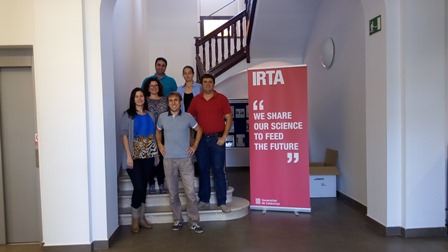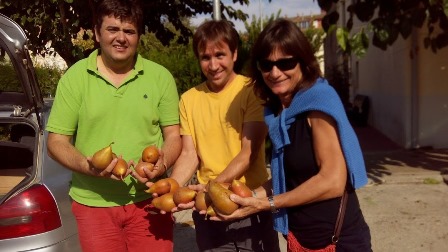 Large-scale methane measurements on individual ruminants for genetic evaluations
Large-scale methane measurements on individual ruminants for genetic evaluations
STSM Filippo Biscarini
My name is Filippo Biscarini, and I currently hold a Principal Investigator position at the Department of Bioinformatics and Biostatistics of PTP Science Park, Italy. I mainly work on the statistical analysis of 'omics data from plant, animal and human scientific projects and experiments.This two-week (18 September - 01 October 2016) “Methagene” COST STSM offered me the opportunity of collaborating with the group of Dr. Juan Pablo Sánchez and Dr. Raquel Quintanilla at the Department of Animal Breeding and Genetics of IRTA (Institut de Recerca i Tecnologia Agroalimentàries) in Caldes de Montbui, Spain.
Here's a picture of myself with (part) of the animal breeding and genetics group at IRTA:

A population of about 800 Holstein cows with genotypes at 115864 SNP loci and phenotypes for milk yield (kg/d), dry matter intake (kg/d) and ruminal methane emissions (g/d) was available.
A G-BLUP model was used for all analyses, in which SNP genotypes were included through the matrix of genomic relationships among animals.
The G-BLUP model was solved both in a Bayesian framework using a Gibbs Sampling MCMC algorithm, and with restricted maximum likelihood (REML) from a frequentist perspective, to compare estimates of genetic parameters.
The interesting aspect of Bayesian methods is that distribution of all parameters in the model are obtained, thus providing information on the variability of estimates; any sensible metric can then be employed to obtain the central tendency (e.g. median, mean, mode of the posterior distribution) and a credible interval around it (e.g. probability that the parameter is above/below a specific value or included in a specific range of values). In particular, for a Bayesian GWAS, the mean of the proportion of the variance explained by the SNP could be used to detect associations, or the probability that such proportion is above a certain threshold (e.g. 1%). Since all SNP are included in the model, and marginal posterior distributions are used for inferences, there is potentially no problem of mutliple-testing in Bayesian GWAS.
Besides the hard and interesting scientific work, there have been other pleasant aspects of my visit to IRTA. I got to know much better the Catalan culture (yes, don't forget that Barcelona and surroundings are in Catalunya!) and purlieus.
Here I am harvesting (Catalan) pears in Balaguer; below, a picture of the Estany de Sant Maurici taken during a weekend excursion to the Pyrinees.


The collaboration with Juan Pablo Sánchez and IRTA will certainly continue, as well as the personal friendship!


